The gardens of the Kensington Palace cover around 111 hectares or 275 acres and border Hyde Park on the east. Its main attraction is the Kensington Palace, one of several royal palaces in London.
History
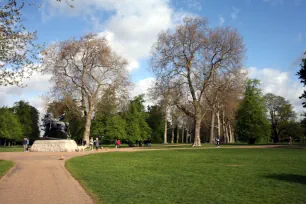
The history of Kensington Gardens started in 1689, when King William III and Mary II bought the Nottingham house in Kensington. The house was turned into a palace by Christopher Wren and the five-hectares-large garden (12 acres) was enlarged by Queen Anne, partly by acquiring forty hectares (100 acres) of Hyde Park in 1705.
The garden was constantly redesigned, especially by Queen Anne and later by Queen Caroline. Queen Anne added the Orangery, a red-brick building north of the Kensington Palace used for housing plants during winter time.
Present Form
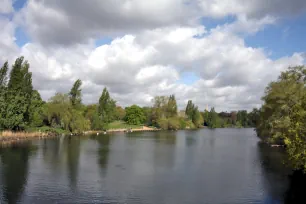
The present form of the Kensington Gardens can be attributed to Queen Caroline, wife of King George II. She added the Round Pond and commissioned the Serpentine and Long Water, a large lake at the eastern end of the Kensington Gardens created from a string of ponds. Two summerhouses were added to the gardens, one of them – the Queen’s Temple – still exists. Queen Victoria added the Italian gardens and the Albert Memorial.
Sights & Attractions
Kensington Gardens is very popular for walking and jogging. Early morning, you’ll encounter plenty of people walking their dog. There are quite a few sights in the park, several of which are on many tourists’ itinerary, including Kensington Palace, the Albert Memorial and the statue of Peter Pan.
Kensington Palace
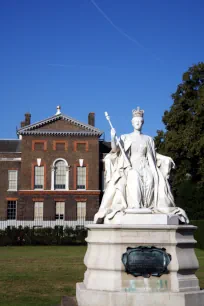
The most famous attraction in Kensington Gardens is without a doubt Kensington Palace ![]() , the former home of Princess Diana and the birthplace of Queen Victoria. The red brick palace was originally built in 1605 as a mansion by the Earl of Nottingham. It became a palace in 1689 when it was bought by King William III. Today, the palace is still a royal residence – Prince William and Kate Middleton live here – but you can visit parts of the palace, including the Queen’s apartments and the Royal Ceremonial Dress Collection. In front of the east side of Kensington Palace is a marble statue of a young Queen Victoria
, the former home of Princess Diana and the birthplace of Queen Victoria. The red brick palace was originally built in 1605 as a mansion by the Earl of Nottingham. It became a palace in 1689 when it was bought by King William III. Today, the palace is still a royal residence – Prince William and Kate Middleton live here – but you can visit parts of the palace, including the Queen’s apartments and the Royal Ceremonial Dress Collection. In front of the east side of Kensington Palace is a marble statue of a young Queen Victoria ![]() , created by her own daughter, Princess Louise, and unveiled in 1893 in the presence of the queen. Another statue stands front of the south side of the palace, behind the so-called Golden Gates. The bronze statue was created in 1907 by the German sculptor Heinrich Baucke and shows King William III
, created by her own daughter, Princess Louise, and unveiled in 1893 in the presence of the queen. Another statue stands front of the south side of the palace, behind the so-called Golden Gates. The bronze statue was created in 1907 by the German sculptor Heinrich Baucke and shows King William III ![]() .
.
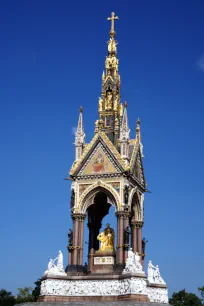
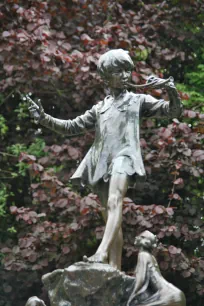
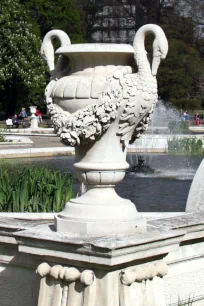
Albert Memorial
At the south end of the Kensington Gardens, you’ll find one of London’s most spectacular monuments: the Albert Memorial ![]() . The Neo-Gothic monument, over fifty meters (175 ft) tall, was built in 1876 in honor of Prince Albert, the consort of Queen Victoria. The monument is designed like a huge medieval shrine and is lavishly decorated with reliefs, sculptures and ornaments. Below the pinnacle is a gilded statue of the prince, who died in 1861 at the age of forty-two.
. The Neo-Gothic monument, over fifty meters (175 ft) tall, was built in 1876 in honor of Prince Albert, the consort of Queen Victoria. The monument is designed like a huge medieval shrine and is lavishly decorated with reliefs, sculptures and ornaments. Below the pinnacle is a gilded statue of the prince, who died in 1861 at the age of forty-two.
Statue of Peter Pan
The statue of the famous fictional character Peter Pan ![]() is another popular monument in Kensington Gardens. It is situated towards the north end of the gardens, near the Long Water. Peter Pan is shown playing the pipes; he stands on a large tree stump, surrounded by small animals. Right below his feet is Tinker Bell, the fairy. The monument was commissioned and paid for by the creator of Peter Pan, the Scottish novelist James M. Barrie. Barrie met the boy who inspired him to create the story of Peter Pan here, in Kensington Gardens.
is another popular monument in Kensington Gardens. It is situated towards the north end of the gardens, near the Long Water. Peter Pan is shown playing the pipes; he stands on a large tree stump, surrounded by small animals. Right below his feet is Tinker Bell, the fairy. The monument was commissioned and paid for by the creator of Peter Pan, the Scottish novelist James M. Barrie. Barrie met the boy who inspired him to create the story of Peter Pan here, in Kensington Gardens.
Italian Gardens
Just north of the statue of Peter Pan, near Hyde Park, lie the ornate Italian Gardens ![]() , a water garden with four octagonal ponds symmetrically arranged around a central marble fountain. Each pond has its own water jets. The garden is enclosed by a beautiful balustrade decorated with numerous reliefs, stone statues and urns.
, a water garden with four octagonal ponds symmetrically arranged around a central marble fountain. Each pond has its own water jets. The garden is enclosed by a beautiful balustrade decorated with numerous reliefs, stone statues and urns.
The Pump House at the north side of the Italian Gardens is designed in the style of an Italian villa. On the east side is a bronze statue of Edward Jenner, an English physician who introduced smallpox vaccinations. The statue was originally erected in Trafalgar Square but was moved here in 1862.
Physical Energy
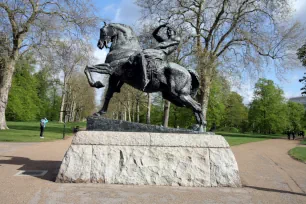
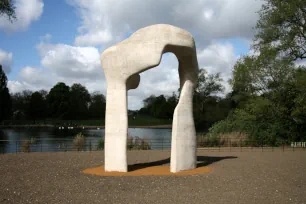
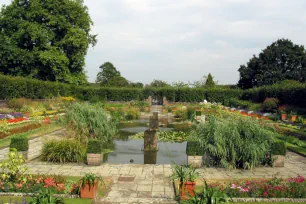
It’s hard to miss the Physical Energy monument ![]() , an equestrian statue located near the center of the Kensington Gardens, at the intersection of several paths. The statue was installed here in 1907 and is a copy of the main statue of the Cecil Rhodes Memorial in Cape Town, South Africa. The statue was created by George Frederic Watts, a British sculptor.
, an equestrian statue located near the center of the Kensington Gardens, at the intersection of several paths. The statue was installed here in 1907 and is a copy of the main statue of the Cecil Rhodes Memorial in Cape Town, South Africa. The statue was created by George Frederic Watts, a British sculptor.
The Arch
When you look towards the west from the Energy statue you can see another, more modern, monument entitled The Arch ![]() . The six-meter tall monument, built from large travertine blocks, was created by the English sculptor Henry Moore. It was erected in 1980 at a prominent spot near the Long Water.
. The six-meter tall monument, built from large travertine blocks, was created by the English sculptor Henry Moore. It was erected in 1980 at a prominent spot near the Long Water.
More Sights
There’s plenty more to see in Kensington Gardens, including another monument: a granite obelisk that commemorates the explorer John Hanning Speke ![]() , who discovered Lake Victoria and the presumed source of the Nile.
, who discovered Lake Victoria and the presumed source of the Nile.
Nearby, near the Long Water, is Queen Caroline’s Temple ![]() , a small eighteenth-century summer pavilion in Neoclassical style. Just south of the temple is one of the park’s main cultural attractions: Serpentine South
, a small eighteenth-century summer pavilion in Neoclassical style. Just south of the temple is one of the park’s main cultural attractions: Serpentine South ![]() , a contemporary art gallery that opened in 1970 in a former tea pavilion. Its sibling Serpentine North
, a contemporary art gallery that opened in 1970 in a former tea pavilion. Its sibling Serpentine North ![]() – another contemporary art gallery – opened in 2013 on the other side of the lake.
– another contemporary art gallery – opened in 2013 on the other side of the lake.
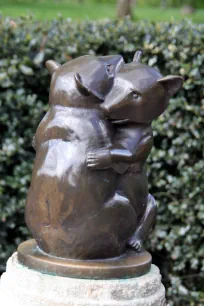
There are also several playgrounds in Kensington Gardens, the latest of which is the Diana, Princess of Wales Memorial Playground, which is themed around Peter Pan.
Just east of Kensington Palace you’ll find the sunken garden, a beautiful garden created in 1908 and originally based on a Tudor garden in Hampton Court. Princess Diana was so fond of this garden that it was revamped into a garden in her memory and renamed The White Garden ![]() in 2017. It has been replanted with Diana’s favorite flowers and in 2021 a statue of Diana was unveiled in the garden.
in 2017. It has been replanted with Diana’s favorite flowers and in 2021 a statue of Diana was unveiled in the garden.
Further east is the Round Pond, a favorite with remote controlled boat enthusiasts. Just south of the Round Pond is the Kensington Gardens Bandstand ![]() , an elegant bandstand that was installed here in 1931 and is still used for summer concerts. Further south, towards Broad walk (the wide straight path that runs along Kensington Palace), a cylindrical engraved stone that marks the the site of an ancient spring, now known as St. Govor’s Well
, an elegant bandstand that was installed here in 1931 and is still used for summer concerts. Further south, towards Broad walk (the wide straight path that runs along Kensington Palace), a cylindrical engraved stone that marks the the site of an ancient spring, now known as St. Govor’s Well ![]() .
.
Just north of the Italian Gardens is Queen Anne’s Alcove ![]() , which was built by Christopher Wren in 1705 for Queen Anne and originally stood in her private garden near Kensington Palace. It moved to its current spot on the edge of Kensington Gardens in 1867. Nearby is Buckhill lodge
, which was built by Christopher Wren in 1705 for Queen Anne and originally stood in her private garden near Kensington Palace. It moved to its current spot on the edge of Kensington Gardens in 1867. Nearby is Buckhill lodge ![]() , a picturesque Victorian cottage built here in 1858.
, a picturesque Victorian cottage built here in 1858.
Finally, a little more to the west, stands the adorable Two Bears Fountain ![]() , with a sculpture of two bears hugging each other. It was erected in 1939 to celebrate the eightieth anniversary of the Metropolitan Drinking Fountain & Cattle Trough Association, which was founded to provide free drinking water for both citizens and animals.
, with a sculpture of two bears hugging each other. It was erected in 1939 to celebrate the eightieth anniversary of the Metropolitan Drinking Fountain & Cattle Trough Association, which was founded to provide free drinking water for both citizens and animals.
Map of Kensington Gardens
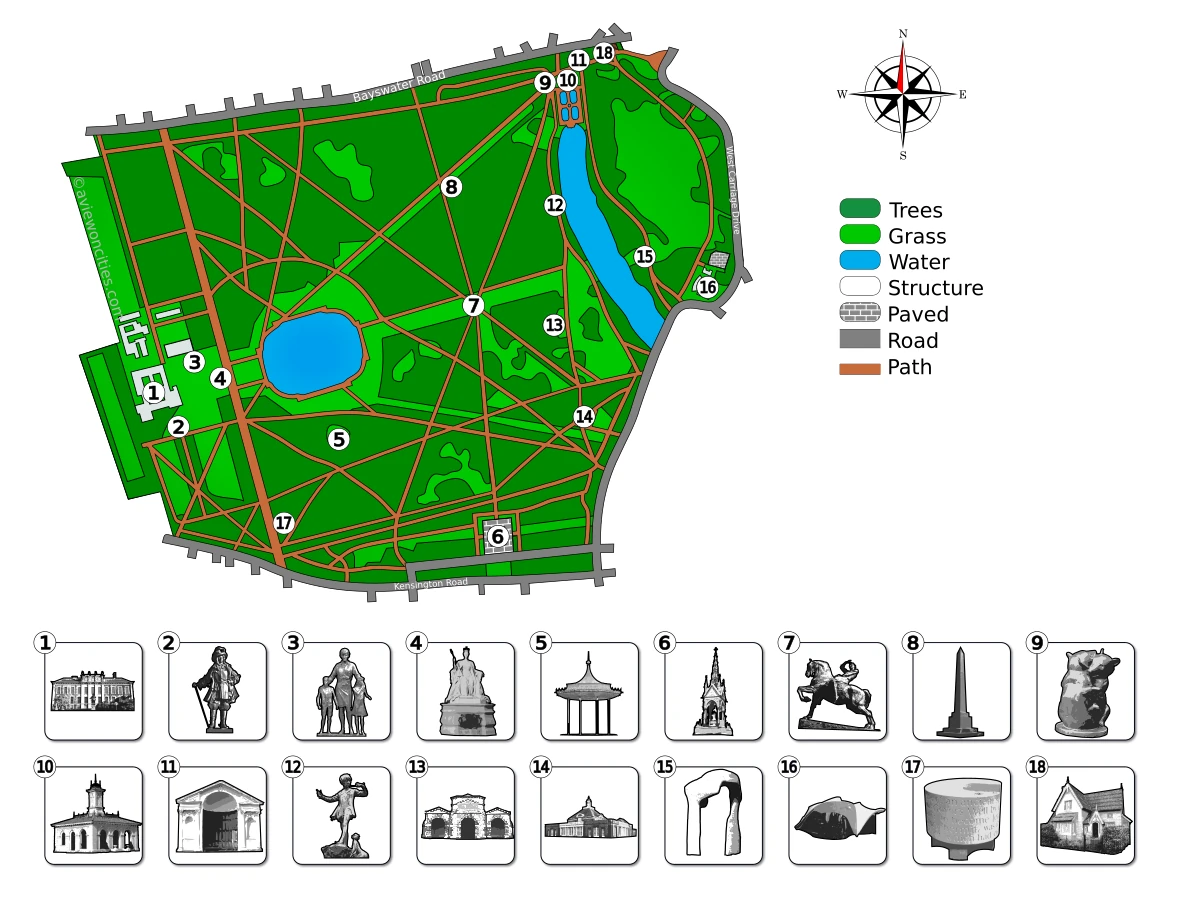
- Next: Tate Modern
- More Sights & Attractions in London

